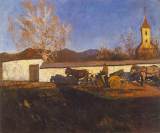

In summer 1896, about 40 artists arrived in Nagybánya, a mining town in the north of Transylvania, to establish an art school for the next 50 years. Artists who worked there during the first summer belonged to two groups: young artists of different nationalities of a private academy led by Simon Hollósy, and artists, mainly Hungarians, who had already made their names. Their works had been exhibited in Műcsarnok (Palace of Art), a conservative art gallery, but the appearance of the reformist group resulted in an open confrontation at the end of 1897. The event which caused sensations, broke the monopoly of Mücsarnok and modern styles became accepted in Hungary. When the works of Károly Ferenczy were first exhibited in the Nemzeti Szalon (National Salon) in Budapest in 1903, it meant a major break-through and success for the Nagybánya school.
Hollósy left Nagybánya in 1901, with some of his pupils following him, and others remaining faithful to Nagybánya. Four major painters of Nagybánya (Károly Ferenczy, Béla Iványi Grünwald, István Réti and János Thorma) decided to train art students in a free school, so they founded the Free School of Painting in Nagybánya in 1902. Later Hollósy took his pupils to Técső, another small town in Transylvania: the art school which he established there was the first branch of the Nagybánya art school. Besides early trends (naturalism, plein air, or Art Nouveau) others appeared, too, during the history of the Nagybánya art school where the movement of the neos started. Members of MIÉNK used to be Nagybánya artists, too, and the art school in Kecskemét was also founded by painters of the Nagybánya school.
The most significant representatives of the first generation in Nagybánya included Károly Ferenczy, Simon Hollósy, Béla Iványi Grünwald, István Réti and János Thorma.